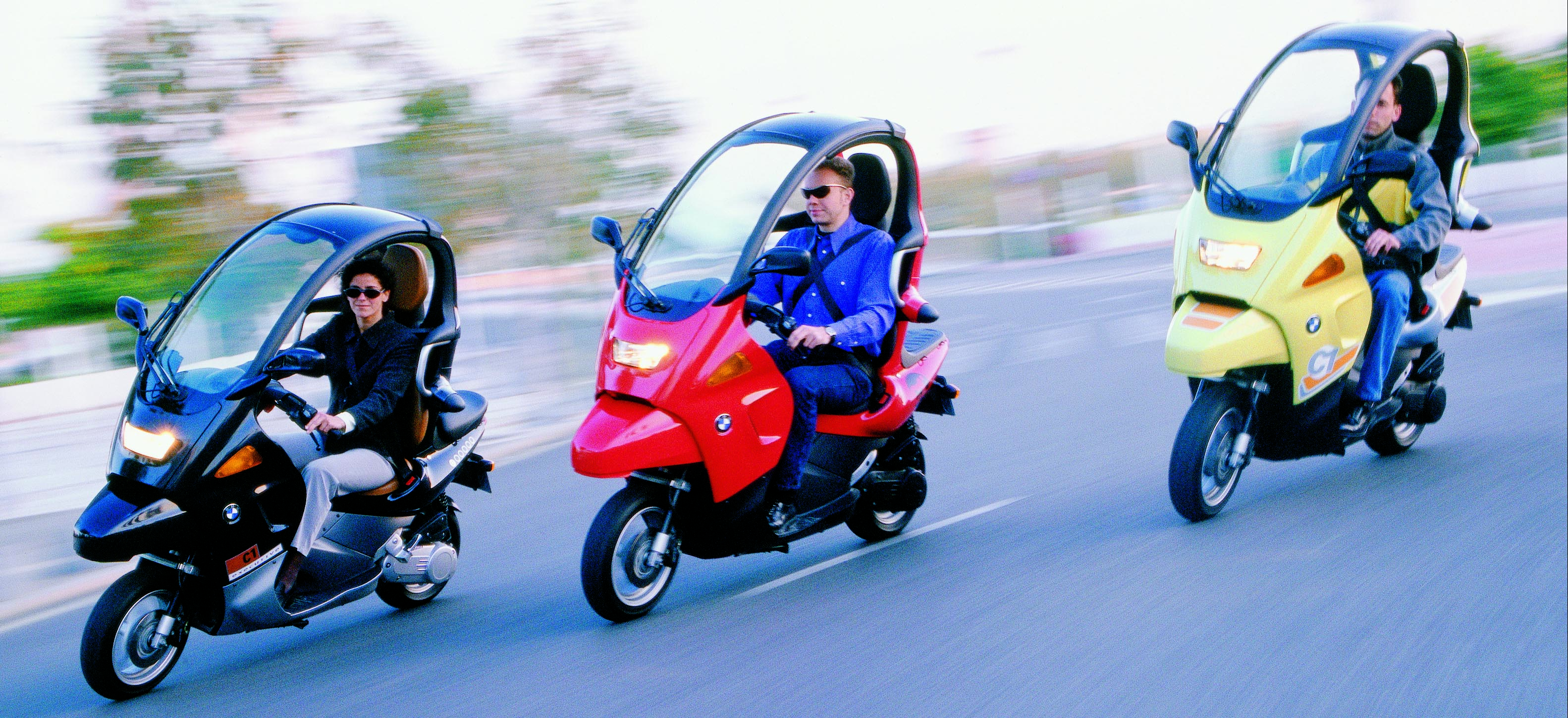Back in the 1920s, an unconventional motorcycle named the Mauser Monotrace was built. It had a wheel at the front and at the rear like a normal motorcycle, but it had doors, car-like seats, a semi-circular steering wheel and stabilisers either side of the body work to help cornering. Unsurprisingly, the design didn’t take off and very few were made.
But at the turn of the millennium, as towns and cities were becoming more and more densely populated, BMW decided that there was something in the whole idea of including some car features on a powered two-wheeler, to enhance safety and the commuting experience, and tempt car drivers away from four wheels and onto two. So, in 2000, the German firm launched a radical new scooter called the C1, with the help of Italian car stylists and auto company, Bertone.
Safety
The C1 scooter’s main safety feature was the protective shell formed by its aluminium frame, roll-bars also made from aluminium, which held the roof and supported the windscreen (complete with screen wipers). Such was the structure’s strength that the BMW could support more than the weight of a car on its roof. The side elements were designed to prevent the rider’s head from hitting the ground if the bike fell over, and the beak above the bike’s front wheel was filled with dense foam (as used in car bumpers) and was designed to absorb energy in the case of a head-on impact.
The Telelever front suspension system, similar to that on other BMW bikes of the time, also acted as an important piece of crash protection. Another key safety feature was the seat and twin seat belts, both of which were designed to stop the rider falling out either side in a crash, with the headrest designed to prevent whiplash. Due to the extensive safety features included on the BMW C1 scooter, riders were exempt from wearing a crash helmet in most European countries – although the UK wasn’t one of them.
However, all of the additional safety features came a cost. It weighed a hefty 185kg, more than big 1000cc sports bikes, and only had 15bhp to play with from the 125cc Rotax single-cylinder engine. When the 125cc BMW C1 was launched, it cost £4,000, which was reduced down by £600 when the 200 version came along (which was actually a 176cc). That’s a lot of money for a scooter today, even more so 20 years ago, when it would have been the equivalent of almost £7000 in today’s money.
Handling
Handling performance was compromised by the weight too, with some of it carried up high thanks to the roof and roll bars, which didn’t make it a demon on twisty roads or long sweeping bends. But that’s not what the C1 was built for. It was meant as an urban commuter and to get car drivers to make the switch and experience the ease of travelling to and from the office more efficiently.
Accessories
Where the C1 really shone compared to its rivals was its levels of equipment and massive list of optional extras. Three variants were available at the time, starting with the basic C1 which, at £4,000 cost as much as Suzuki’s unfaired Bandit 600. The ‘Family’s Friend’ was the middle option and was slightly more expensive, with two-colour graphics, extra luggage space in the fairing and a fitting kit for the top-box accessory.
The top-of-the-range model was the Executive, finished in black, and came complete with accessories including a reading light, a mobile phone holder, luggage net and a bracket for an aluminium brief case, and was £400 more expensive than the standard model. Numerous other accessories were available though, including ABS, heated grips and seat, roof vents, sound system and GPS. A well-equipped C1 would have cost you over £5,000.
Summary
It was a big welcome to the 21st Century from BMW when they announced the C1 in 2000. BMW’s intention was to appeal to car drivers in crowded cities who were fed up with the traffic-stricken daily commute. The idea was to offer the convenience of a scooter but without many of the dangers or hassles commonly associated with motorcycling.
In many ways they succeeded. Nothing came close to it in terms of its looks or levels of equipment, and you couldn’t argue with its practicality either. Although being expensive, BMW sold 10,614 units in 2001, but it was only one year later when sales figures dropped dramatically to only 2,000, which caused production of the C1 to end in October 2002.
The C1 was a unique machine, and still is. For the first time ever it combined the feel, fun, traffic-beating ability and parking ease of a motorcycle with a substantial amount of the safety and weather protection offered by a car, and it still has a cult following today.
Perhaps the cards didn’t quite fall for BMW as they hoped it would with the C1. It was clearly aimed at getting car drivers on scooters, but the legislators didn’t make things easy for them. The law treated it as a motorcycle and although some countries granted an exemption, most insisted on helmets being worn. Likewise, riders in most countries needed to take their bike licence or run with L plates and a CBT, as was the case in Britain, meaning that it wasn’t quite as accessible as BMW would have liked.
BMW’s car know-how made the C1 possible. Will we ever see something like it again? Who knows? But we wouldn’t be too surprised to see something similar emerge again in the future.



